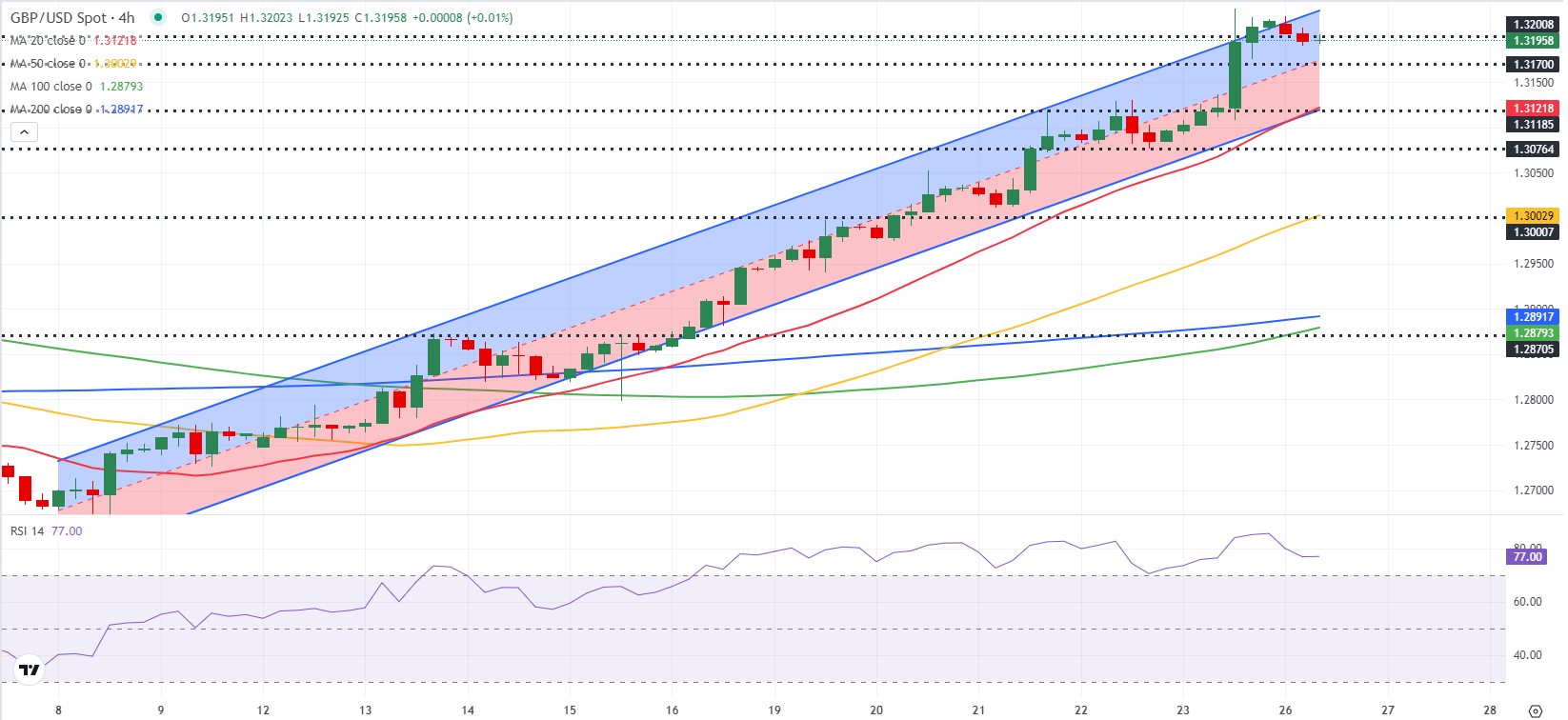- GBP/USD consolidates previous week's impressive gains below 1.3200.
- Fed Chairman Powell's remarks on Friday triggered a USD selloff.
- The pair remains technically overbought ahead of US Durable Goods Orders data.
GBP/USD gained 1% on Friday and rose more than 2% for the week, fuelled by the heavy selling pressure surrounding the US Dollar (USD). After touching its highest level since March 2020 at 1.3230, the pair seems to have entered a consolidation phase below 1.3200 at the beginning of the week.
British Pound PRICE Last 7 days
The table below shows the percentage change of British Pound (GBP) against listed major currencies last 7 days. British Pound was the strongest against the US Dollar.
| USD | EUR | GBP | JPY | CAD | AUD | NZD | CHF | |
|---|---|---|---|---|---|---|---|---|
| USD | -1.40% | -1.90% | -2.53% | -1.30% | -1.55% | -2.60% | -2.21% | |
| EUR | 1.40% | -0.60% | -1.09% | 0.10% | -0.25% | -1.38% | -0.86% | |
| GBP | 1.90% | 0.60% | -0.66% | 0.67% | 0.34% | -0.73% | -0.27% | |
| JPY | 2.53% | 1.09% | 0.66% | 1.20% | 0.97% | 0.05% | 0.19% | |
| CAD | 1.30% | -0.10% | -0.67% | -1.20% | -0.29% | -1.23% | -0.97% | |
| AUD | 1.55% | 0.25% | -0.34% | -0.97% | 0.29% | -0.98% | -0.61% | |
| NZD | 2.60% | 1.38% | 0.73% | -0.05% | 1.23% | 0.98% | 0.41% | |
| CHF | 2.21% | 0.86% | 0.27% | -0.19% | 0.97% | 0.61% | -0.41% |
The heat map shows percentage changes of major currencies against each other. The base currency is picked from the left column, while the quote currency is picked from the top row. For example, if you pick the British Pound from the left column and move along the horizontal line to the US Dollar, the percentage change displayed in the box will represent GBP (base)/USD (quote).
Following Thursday's recovery attempt, the USD Index, which tracks the USD's valuation against a basket of six major currencies, turned south on Friday.
In his keynote speech at the annual Jackson Hole Economic Symposium on Friday, Federal Reserve (Fed) Chairman Jerome Powell noted that the labor market is no longer overheated and said that they will do everything they can to support a strong labor market, while making further progress toward price stability. He also acknowledged that the time has come for them to adjust the monetary policy.
The US economic docket will feature Durable Goods Orders data for July later in the day. The market expectation is for a 4% increase, following the 6.7% contraction recorded in June. Although this data by itself is unlikely to influence the Fed's policy outlook, it could trigger a short-lasting reaction. A negative print could weigh on the USD, while a noticeable rebound, with a reading of 5% or stronger, could support the USD and cause GBP/USD to correct lower.
GBP/USD Technical Analysis
GBP/USD started to edge lower after rising above the upper limit of the ascending channel, suggesting that the pair is staging a technical correction. The Relative Strength Index (RSI) indicator on the 4-hour chart stays well above 70, hinting that the pair has more room on the downside to complete its correction.
1.3170 (mid-point of the ascending channel) aligns as first support before 1.3120 (lower limit of the ascending channel) and 1.3100 (psychological level, static level). On the upside, 1.3200 (static level, psychological level) could be seen as immediate resistance before 1.3230 (upper limit of the ascending channel) and 1.3270 (static level from March 2022).
Pound Sterling FAQs
The Pound Sterling (GBP) is the oldest currency in the world (886 AD) and the official currency of the United Kingdom. It is the fourth most traded unit for foreign exchange (FX) in the world, accounting for 12% of all transactions, averaging $630 billion a day, according to 2022 data. Its key trading pairs are GBP/USD, aka ‘Cable’, which accounts for 11% of FX, GBP/JPY, or the ‘Dragon’ as it is known by traders (3%), and EUR/GBP (2%). The Pound Sterling is issued by the Bank of England (BoE).
The single most important factor influencing the value of the Pound Sterling is monetary policy decided by the Bank of England. The BoE bases its decisions on whether it has achieved its primary goal of “price stability” – a steady inflation rate of around 2%. Its primary tool for achieving this is the adjustment of interest rates. When inflation is too high, the BoE will try to rein it in by raising interest rates, making it more expensive for people and businesses to access credit. This is generally positive for GBP, as higher interest rates make the UK a more attractive place for global investors to park their money. When inflation falls too low it is a sign economic growth is slowing. In this scenario, the BoE will consider lowering interest rates to cheapen credit so businesses will borrow more to invest in growth-generating projects.
Data releases gauge the health of the economy and can impact the value of the Pound Sterling. Indicators such as GDP, Manufacturing and Services PMIs, and employment can all influence the direction of the GBP. A strong economy is good for Sterling. Not only does it attract more foreign investment but it may encourage the BoE to put up interest rates, which will directly strengthen GBP. Otherwise, if economic data is weak, the Pound Sterling is likely to fall.
Another significant data release for the Pound Sterling is the Trade Balance. This indicator measures the difference between what a country earns from its exports and what it spends on imports over a given period. If a country produces highly sought-after exports, its currency will benefit purely from the extra demand created from foreign buyers seeking to purchase these goods. Therefore, a positive net Trade Balance strengthens a currency and vice versa for a negative balance.
Information on these pages contains forward-looking statements that involve risks and uncertainties. Markets and instruments profiled on this page are for informational purposes only and should not in any way come across as a recommendation to buy or sell in these assets. You should do your own thorough research before making any investment decisions. FXStreet does not in any way guarantee that this information is free from mistakes, errors, or material misstatements. It also does not guarantee that this information is of a timely nature. Investing in Open Markets involves a great deal of risk, including the loss of all or a portion of your investment, as well as emotional distress. All risks, losses and costs associated with investing, including total loss of principal, are your responsibility. The views and opinions expressed in this article are those of the authors and do not necessarily reflect the official policy or position of FXStreet nor its advertisers. The author will not be held responsible for information that is found at the end of links posted on this page.
If not otherwise explicitly mentioned in the body of the article, at the time of writing, the author has no position in any stock mentioned in this article and no business relationship with any company mentioned. The author has not received compensation for writing this article, other than from FXStreet.
FXStreet and the author do not provide personalized recommendations. The author makes no representations as to the accuracy, completeness, or suitability of this information. FXStreet and the author will not be liable for any errors, omissions or any losses, injuries or damages arising from this information and its display or use. Errors and omissions excepted.
The author and FXStreet are not registered investment advisors and nothing in this article is intended to be investment advice.
Recommended Content
Editors’ Picks

Gold moves to record highs past $3,340
Gold now gathers extra steam and advances beyond the $3,340 mark per troy ounce on Wednesday, hitting all-time highs amid ongoing worries over escalating US-China trade tensions, a weaker US Dollar and lack of news from Powell's speech.

AUD/USD: Upside now refocuses the 200-day SMA
AUD/USD advanced for the sixth consecutive daily advance, picking up extra upside impulse on the back of the continuation of the sell-off in the US Dollar. Next on tap for the Aussie now emerges the yearly peak above 0.6400 prior to the key 200-day SMA.

EUR/USD looks to retest its 2025 highs
EUR/USD reversed two consecutive daily retracements and revisited the key 1.1400 neighbourhood as the selling bias in the Greenback gathered extra pace, always against the backdrop of rising uncertainty surrounding US yields. Chief Powell, in the meantime, delivered a neutral message in his discussion over the economic outlook.

Bitcoin held steady as US reveals China faces up to 245% tariffs
Bitcoin (BTC) witnessed little pressure on Wednesday despite the Chinese government selling off parts of its confiscated cryptocurrency holdings.

Future-proofing portfolios: A playbook for tariff and recession risks
It does seem like we will be talking tariffs for a while. And if tariffs stay — in some shape or form — even after negotiations, we’ll likely be talking about recession too. Higher input costs, persistent inflation, and tighter monetary policy are already weighing on global growth.

The Best brokers to trade EUR/USD
SPONSORED Discover the top brokers for trading EUR/USD in 2025. Our list features brokers with competitive spreads, fast execution, and powerful platforms. Whether you're a beginner or an expert, find the right partner to navigate the dynamic Forex market.
